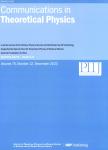Schrodinger and Klein-Gordon theories of black holes from the quantization of the Oppenheimer and Snyder gravitational collapse
作者机构:SUNY Polytechnic Institute13502 UticaNew YorkUSAIstituto Livi59100 PratoTuscanyItaly and International Institute for Applicable Mathematics and Information SciencesB M Birla Science CentreAdarshnagarHyderabad 500063India
出 版 物:《Communications in Theoretical Physics》 (理论物理通讯(英文版))
年 卷 期:2023年第75卷第9期
页 面:122-135页
核心收录:
学科分类:07[理学] 070401[理学-天体物理] 0704[理学-天文学]
基 金:The author thanks two unknown referees for very useful comments and suggestions
主 题:quantum black holes information paradox quantum shells quantum levels Schrodinger and Klein-Gordon theories
摘 要:The Schrodinger equation of the Schwarzschild black hole(BH) has been recently derived by the author and collaborators. The BH is composed of a particle, the electron , interacting with a central field, the nucleus . Via de Broglie s hypothesis, one interprets the electron in terms of BH horizon s modes. Quantum gravity effects modify the BH semi-classical structure at the Schwarzschild scale rather than at the Planck scale. The analogy between this BH Schrodinger equation and the Schrodinger equation of the s states of the hydrogen atom permits us to solve the same equation. The quantum gravitational quantities analogous of the fine structure constant and of the Rydberg constant are not constants, but the dynamical quantities have well-defined discrete spectra. The spectrum of the gravitational fine structure constant is the set of non-zero natural numbers. Therefore, BHs are well-defined quantum gravitational systems obeying Schrodinger s theory: the gravitational hydrogen atoms . By identifying the potential energy in the BH Schrodinger equation as being the gravitational energy of a spherically symmetric shell, a different nature of the quantum BH seems to surface. BHs are self-interacting, highly excited,spherically symmetric, massive quantum shells generated by matter condensing on the apparent horizon, concretely realizing the membrane paradigm. The quantum BH described as a gravitational hydrogen atom is a fictitious mathematical representation of the real, quantum BH, a quantum massive shell having a radius equal to the oscillating gravitational *** consequences emerge from this result:(i) BHs have neither horizons nor singularities;(ii) there is neither information loss in BH evaporation, nor BH complementarity, nor firewall paradox. These results are consistent with previous ones by Hawking, Vaz, Mitra and ***, the special relativistic corrections to the BH Schrodinger equation give the BH Klein–Gordon equation and the cor



